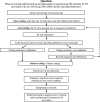To Turn or Not to Turn: Exploring Nurses' Decision-Making Processes Concerning Regular Turning of Nursing Home Residents
- PMID: 34631970
- PMCID: PMC8493305
- DOI: 10.1177/23337214211046088
To Turn or Not to Turn: Exploring Nurses' Decision-Making Processes Concerning Regular Turning of Nursing Home Residents
Abstract
Background: Nursing home (NH) residents are at high-risk for pressure injuries (PrIs), and those living with Alzheimer's Disease and Related Dementias (ADRD) are at even greater risk. Understanding how nursing staff approach repositioning remains critical. Methods: As part of an ongoing clinical trial, this mixed-method prospective, exploratory, descriptive study examined repositioning efforts for PrI prevention. An investigator-developed checklist guided researcher observations, and focus groups revealed staff perspective on resident behaviors and corresponding repositioning approaches. Focus group transcripts were analyzed using the constant comparative coding method. Results: Repositioning observations were conducted for 88 residents. Resident behaviors and nursing approaches were similar between the ADRD (n = 62, 70%) and non-ADRD (n = 26, 30%) groups. Thirty-six staff participated in one of six focus group sessions. A conceptual model was developed to depict the repositioning process. Staff revealed care is guided by clinical frameworks and guidelines, along with resident preferences and behaviors. Conclusions: Protocol-driven, standardized PrI prevention care may limit the capacity to honor repositioning preferences. Insights from the focus groups highlight the importance of being cognizant of competing factors that may interfere with successful repositioning. Approaches by staff may be protocol-driven or an integrated method of care.
Keywords: Alzheimer’s/Dementia; aging; long-term care; nursing.
© The Author(s) 2021.
Conflict of interest statement
Declaration of Conflicting Interests: The author(s) declared no potential conflicts of interest with respect to the research, authorship, and/or publication of this article.
Figures
Similar articles
-
Effect of Varying Repositioning Frequency on Pressure Injury Prevention in Nursing Home Residents: TEAM-UP Trial Results.Adv Skin Wound Care. 2022 Jun 1;35(6):315-325. doi: 10.1097/01.ASW.0000817840.68588.04. Adv Skin Wound Care. 2022. PMID: 35051978 Free PMC article. Clinical Trial.
-
Evaluating non-pharmacological approaches to nursing home dementia care: A protocol.Contemp Clin Trials Commun. 2023 Aug;34:101161. doi: 10.1016/j.conctc.2023.101161. Epub 2023 Jun 15. Contemp Clin Trials Commun. 2023. PMID: 37347001 Free PMC article.
-
Characteristics of Nursing Home Resident Movement Patterns: Results from the TEAM-UP Trial.Adv Skin Wound Care. 2022 May 1;35(5):271-280. doi: 10.1097/01.ASW.0000822696.67886.67. Adv Skin Wound Care. 2022. PMID: 35195085 Free PMC article. Clinical Trial.
-
Development and Implementation of an Individualized Turning Program for Pressure Injury Prevention Using Sensor Technology in Nursing Homes: A Quality Improvement Program.Wound Manag Prev. 2021 Nov;67(11):12-25. Wound Manag Prev. 2021. PMID: 35030094
-
Quality of Nursing Homes and Admission of Residents With Alzheimer's Disease and Related Dementias: The Potential Influence of Market Factors and State Policies.J Am Med Dir Assoc. 2020 Nov;21(11):1671-1676.e1. doi: 10.1016/j.jamda.2020.04.028. Epub 2020 Jun 19. J Am Med Dir Assoc. 2020. PMID: 32565275 Free PMC article.
References
-
- American Nurses Association (2021). Nursing: Scope and standards of practice (4th ed.). American Nurses Association.
-
- Bergstrom N., Braden B. J., Laguzza A., Holman V. (1987. a). The Braden Scale for predicting pressure sore risk. Nursing Research, 36(4), 205-210. - PubMed
-
- Bergstrom N., Demuth P. J., Braden B. J. (1987. b). A clinical trial of the Braden Scale for predicting pressure sore risk. Nursing Clinics of North America, 22(2), 417-428. - PubMed
Grants and funding
LinkOut - more resources
Full Text Sources
Research Materials



